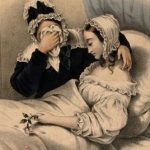 History
History  History
History  Weird Stuff
Weird Stuff 10 Everyday Products Surprisingly Made by Inmates
 Movies and TV
Movies and TV 10 Actors Dragged out of Retirement for One Key Role
 Creepy
Creepy 10 Lesser-Known Shapeshifter Legends from Around the World
 Animals
Animals 10 Amazing Animal Tales from the Ancient World
 Gaming
Gaming 10 Game Characters Everyone Hated Playing
 Books
Books 10 Famous Writers Who Were Hypocritical
 Humans
Humans 10 of the World’s Toughest Puzzles Solved in Record Time
 Mysteries
Mysteries 10 Scientific Mysteries We Don’t Fully Understand
 Weird Stuff
Weird Stuff 10 Celebrities Who Have Admitted to Alien Encounters
 History
History Ten Revealing Facts about Daily Domestic Life in the Old West
 Weird Stuff
Weird Stuff 10 Everyday Products Surprisingly Made by Inmates
 Movies and TV
Movies and TV 10 Actors Dragged out of Retirement for One Key Role
Who's Behind Listverse?

Jamie Frater
Head Editor
Jamie founded Listverse due to an insatiable desire to share fascinating, obscure, and bizarre facts. He has been a guest speaker on numerous national radio and television stations and is a five time published author.
More About Us Creepy
Creepy 10 Lesser-Known Shapeshifter Legends from Around the World
 Animals
Animals 10 Amazing Animal Tales from the Ancient World
 Gaming
Gaming 10 Game Characters Everyone Hated Playing
 Books
Books 10 Famous Writers Who Were Hypocritical
 Humans
Humans 10 of the World’s Toughest Puzzles Solved in Record Time
 Mysteries
Mysteries 10 Scientific Mysteries We Don’t Fully Understand
 Weird Stuff
Weird Stuff 10 Celebrities Who Have Admitted to Alien Encounters
Ten Ways Massive Death Tolls Have Affected Human Society
Death, the great equalizer, is an inevitable fate cast upon the human race as we are brought into this world. Every breath may well be our last. At times, death comes quicker than others, ravaging large populations swiftly and without mercy. In modern times we’ve seen the horrors of a deadly disease tear apart our culture, families, and societal norms.
Devastating at first, we are now seeing the changes this earth-shattering virus produced. More people are working from home and are connected more than ever via the internet. Also, who doesn’t love food delivered right to their doorstep? While seemingly novel in modern times, it is not the first time the loss of millions of lives carved out a path of progress.
So here are 10 ways massive death tolls have affected human society.
Related: 10 Strange Omens That Warned Of Death
10 Mosquitoes, the Louisiana Purchase, and a Free Haiti
After attempting to quell the first successful slave revolt in the world on the island of Haiti, Napoleon Bonaparte signed off the Louisiana Territory to Thomas Jefferson and the United States, while Haiti became the first independent black nation in the western world.
St. Domingue, as it was called then, had a massive amount of mosquitoes. Many fatalities were caused during the 1791 Haitian Revolution due to diseases such as yellow fever and malaria. General Charles Leclerc, Napoleon Bonaparte’s brother-in-law and commander of the French forces on the island, estimated that 100-200 men were dying a day due to yellow fever.
On November 2, 1802, Leclerc would die of the disease. In addition, over 24,000 colonialists died—out of the 40,000 there—due to the brave efforts of Haitian freedom fighters and the effects of yellow fever. The island had an overwhelming population of 500,000 slaves at the time, and 100,000 of them would die fighting for their independence. Many of them were immune to the disease, instead dying during the brutal fighting. Napoleon cut his losses before their independence in 1804, selling the 828,000-square-mile (2.14-million-square-kilometer) colony of Louisiana to America for $15 million in December of 1803. It still stands as one of the cheapest land deals in world history.[1]
9 The Black Plague Brings Economic Power to Lower Classes
The Black Plague, Yersinia pestis, spread from the shabby, worn-down docks of Italy to the frost-bitten plains of Russia between 1347 and 1351. Fleas carried the disease from rodents to humans, and in its wake, nearly 20 million people died. Some estimates hike that number even further up to 28 million. While this catastrophe laid waste to a vibrant yet conflicted, flourishing society, it paved the way for an even more prosperous social structure to emerge.
Before the Black Plague, nine out of ten common folk made their living as farmers. Crops were generally of poor quality due to the high demand of the aristocracy. Over-fallowing of the soil led to poor conditions and crops. After the plague, nearly three-fourths of the European population was decimated, including the landowning class. Yet the land prospered. It became healthier as grain stocks now overflowed and fallowing was needed less.
A smaller population also meant higher wages for those who survived, and in turn, many peasants demanded greater economic satisfaction. Cash crops such as olives, grapes, apples, pears, and hops became more common as farmers started attending to their own profits. A mercantile class emerged, forging the early elements of the middle class. This new class of peasants greatly enjoyed their newfound freedoms, and once unheard of in medieval Europe, rebellions began to emerge.[2]
8 The Black Plague Ushered in Higher Education
Many nuns and holy men passed away due to the Black Plague. Since medicine and general knowledge were lacking at the time, the Catholic Church sent these holy servants to heal the sick with the power of God in hospitals and infirmaries. This, however, only decimated their numbers as they were not immune to the disease, despite their faith in the Lord.
In order for the Church to recoup its losses and train more clergymen quickly, many universities were founded for the first time. In addition, many educators passed due to the bubonic plague, and education standards plummeted. Civic-minded members of the upper class often founded centers of higher education to tackle both issues. For example, Trinity Hall of Cambridge University was founded in 1350 by the Bishop of Norwich, William Bateman.[3]
7 The American Civil War and U.S. Industrialization
With over 600,000 casualties, the American Civil War represents the largest loss of American life on United States soil. The agricultural and primarily slave-based economy of the southern states fell apart, and the industrial north took control of the once-divided nation. Due to industrial progress and the laissez-faire attitude of American economics, railroad lines quickly sprang up across the country.
The post-war economy boomed as many southern workers moved north for work, and the cloistered wartime economy came to an end. Soon the United States was outproducing many western European nations. Coupled with continuous waves of immigration and a larger workforce, this led to large amounts of exports to other nations via foodstuffs, raw materials, textiles, and crafted goods. While the legacy of the Civil War did not end racial tensions in the United States, and industrialization led the world to the effects of climate change we see today, it did power progress. And this created many of the modern amenities we often take for granted.[4]
6 The Ambulance Emerged from the American Civil War
In 1864, the United States Congress created the Union Army Ambulance Corps to swiftly whisk wounded soldiers away from the battlefield to safety. While not the first ambulance service to be used in world history, the first civilian ambulance service being created in London in 1832, it was the beginning of the modern ambulance that continues to save countless lives today.
The first hospital civilian ambulance service was offered by a hospital in Cincinnati, Ohio, in 1865. In 1869, a former Union Surgeon, Edward B. Dalton, started a service out of Bellevue Hospital in New York City. Due to the economic boom and industrialization following the Civil War, American ambulance services quickly grew and set the bar for hospital transportation to this day.[5]
5 The Vietnam War Ended the World Economy’s Dependency on Gold
Before 1944, the world economy was based on the price of gold. After WW2, the United States held the highest amount of gold reserves in the world, roughly three-fourths of the world supply. When the International Monetary Fund was founded in July of 1944, it was formed to help war-torn European nations recover from the devastation of WW2 and counteract hyperinflation that emerged due to wartime costs. Countries could redeem U.S. dollars for gold at $35 an ounce, stabilizing a formerly shaky economic system.
Due to the high cost of the Vietnam War—$141 billion in 14 years supporting both American troops and the South Vietnamese army—a devalued dollar, and a competitive market, there was an influx of U.S. dollars within the world system. By 1971, American President Richard Nixon had imposed wage/price controls and ended the world’s reliance on the U.S. dollar, essentially ending the gold standard.
Currencies of the world floated against each other as they still do today. Two million Vietnamese lives were lost during the war, along with 58,000 American casualties. The war is largely seen as the first American military loss in world history. It permanently changed the world’s economy and marked the downfall of America’s most prosperous period.[6]
4 From World War II Nazis to the Moon
On June 20, 1945, Dr. Wernher Von Braun was brought to the United States to assist American scientists in developing intercontinental ballistic missiles. Van Braun, however, was a former Nazi officer, a part of the Nazi party since the 1930s, and an SS officer. The Nazis devastated the population of Europe, killing an estimated 17 million people in their efforts to “cleanse” human society during and leading up to WW2. However, Von Braun was deemed valuable to the U.S. government for inventing the V2 rocket, the first sub-orbital cruiser missile in world history.
Charges against his war crimes were diminished in an effort to further American prowess across the globe. He was one of many scientists brought into the U.S. scientific community in a secret maneuver by the CIA known as Operation Paperclip. Over 500 scientists were brought to the United States to combat Soviet technology following the war. Eventually, this would lead to the founding of NASA and the implementation of the V2 rocket in the Apollo 11 spacecraft. On July 16, 1969, man landed on the moon for the first time—thanks to this notorious war criminal.[7]
3 The Atomic Bomb Helped Create Toyota and Hitachi
Before World War II and the horrors of the atomic bomb, Japan’s economy was controlled by ten major companies known as “Zaibatsu.” They had been in existence since 1868, when 70% of Japan’s population was agricultural, using large tax revenues to fund their enterprises.
When Japan accepted the terms of the Postdam Agreement and an unconditional surrender on August 10, 1945, over 200,000 people had died due to the release of two atomic bombs on the island nation. During the American reconstruction of Japan, the Zaibatsu was disintegrated, and free-market capitalism flourished. Companies such as Toyota and Hitachi emerged and brought us the technological wonders we continue to enjoy today.[8]
2 WWI Solidified Women’s Right to Vote in America
World War I acted as the final straw for women across the globe during the start of the 20th century. Men were away at war, and women took their place across factories and workplaces around the world. It added fire to an already growing movement. Women in various countries demanded equality for their efforts and the right to vote.
In the years following the deadliest war in world history, with somewhere between nine and ten million wartime casualties, women in the United States, Canada, Great Britain, Germany, Poland, Austria, and the Netherlands gained this right and much more.[9]
1 Volcanic Eruption of Pompeii and Western Art & Culture
The destruction of Pompeii claimed over 16,000 lives in total, encasing over 2,000 villagers of the small Italian town eternally in ash. Abandoned until 1748, the rediscovery of the ruins in Pompeii uncovered the beautiful classical buildings of the city. This led to an explosion in Neoclassical, Greek, and Italianate architecture around the world.
Stucco, a distinct discovery within the ruins of Pompeii, became more commonly used among Western buildings. Most noted as being used by Scottish architect Robert Adam, it is still used to this day in many Western homes. This and other archaeological excavations helped to spur the Greek revival cultural movement that many western countries lived by throughout the 1800s.[10]








